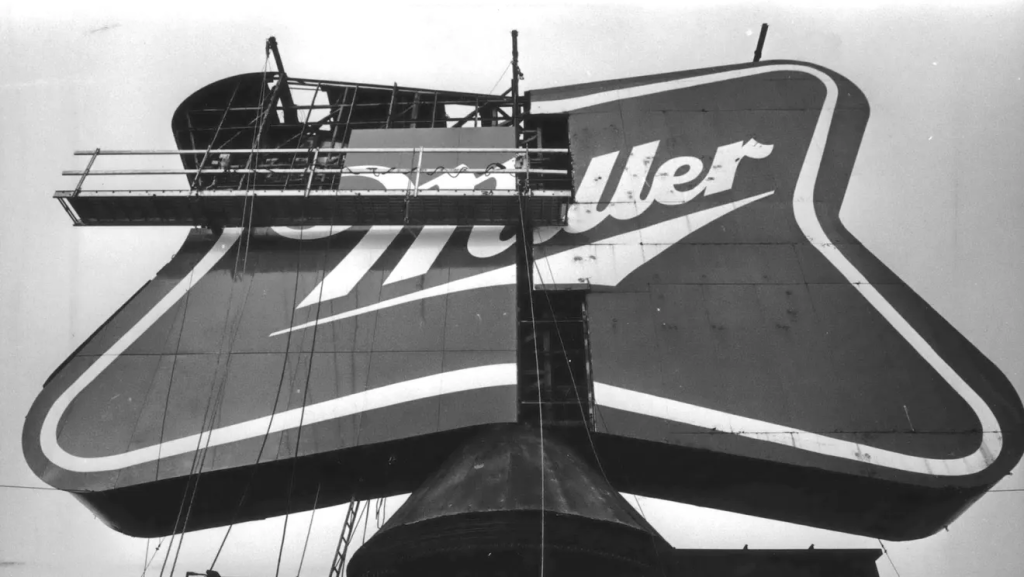
Miller Lite: Tastes great, less filling — and, possibly, saved brewing in Milwaukee

Milwaukee Journal Sentinel
June 30, 2025, 5:01 a. m. CT
There’s brewing before Miller Lite, and there’s brewing after Miller Lite.
When Milwaukee-based Miller Brewing Co. launched Miller Lite in 1975, light beer had a shot-glass share of the beer market in the United States.
Fifty years later, four of the top five beers in the country are light beers — a market segment that didn’t really exist before Miller Lite.
“It revolutionized the industry — that’s the simplest way to put it,” said Benj Steinman, publisher and editor of Beer Marketer’s Insights, a newsletter that has tracked the U.S. brewing industry since 1970.
Miller Lite also might have saved the beer industry in Milwaukee. Or at least, kept it from disappearing.

The beer helped Miller Brewing grow dramatically in the 1970s and ’80s to become America’s second-largest beer company, while Milwaukee’s other two major breweries — Schlitz and Pabst — started to decline.
Schlitz ceased brewing beer in Milwaukee in 1981 and was sold to Stroh Brewing Co. in 1982; Pabst, after years of takeover battles, declining sales and other challenges, closed its breweries in 1996, converting to a “virtual” brewer with other plants making their product.
But Miller survived and even grew, jumping from the nation’s seventh-largest brewer in 1970 to No. 2 by 1980. It has stayed there and kept major brewing operations in Milwaukee, as Miller Brewing, MillerCoors and, since 2016, Molson Coors.
RELATED: The 5 breweries that made Milwaukee famous: Miller, Schlitz, Pabst, Gettelman and Blatz
You could make a case that Milwaukee kept its identity as Brew City thanks to Miller, and Miller stayed Miller thanks to Miller Lite.
“People ask me sometimes why did Miller survive and Pabst and Schlitz and Blatz didn’t, and I tell them, the short answer is Miller Lite,” Daniel Scholzen, archivist for Molson Coors, said in an interview.

How Miller Lite was born
How did Miller Lite save Miller Brewing?
It started with an acquisition. Make that a double.
Founded in Milwaukee in 1855, Miller Brewing had been a solid company for more a century. But even under the dynamic leadership of Frederick C. Miller — who died in 1954, in a plane crash that also killed his son and likely successor, Fred Jr. — Miller Brewing couldn’t crack the top five of America’s largest beermakers.
It was even No. 3 in its hometown, trailing both Schlitz and Pabst.
That began to change when tobacco conglomerate Philip Morris bought a controlling interest in Miller Brewing in 1969.
Like most national breweries, Miller had never been shy about advertising. But Philip Morris was in another league.
“Philip Morris spent more money on marketing than anybody ever had spent on marketing before in the industry,” Scholzen said. “Miller was transformed by that acquisition.”
First, Philip Morris set out to boost Miller High Life, the brewery’s sole national brand at the time, with a massive marketing campaign to rebrand “the champagne of bottled beers” as a workingman’s brew. The company filled tons of television time and print space, using a winning jingle (“If you’ve got the time, we’ve got the beer”) and one of the most enduring slogans in brewing history: “It’s Miller time.”
But to take Miller to the next level, the new owners needed more national brands. So Miller bought the assets of Meister Brau, a Chicago brewery then in bankruptcy. Among its assets was a low-calorie product called Meister Brau Lite.
Brewing industry legend Joseph Owades, a biochemist by trade, is credited with inventing light beer. The first product, released in 1967, was Gablinger’s Diet Beer. Meister Brau used a version of Owades’ recipe to create Meister Brau Lite.
There were only one thing wrong with Meister Brau Lite: It didn’t taste very good.
“Whereas other breweries saw it as a joke, a novelty at best — diet beer? — Miller saw an opportunity,” Scholzen said, for a quality beer “that just happened to have fewer calories, rather than a low-calorie version of an existing brand.”
The decision to lean into making a beer with lower calories without sacrificing taste came during a time when baby boomers were starting to reach legal drinking age — a key factor in helping Miller Lite catch on quickly with new beer drinkers when Miller Lite launched in 1975, Steinman said.
“The market was just ready for light beers to erupt on the scene,” he said. “And Miller Lite was the first embodiment of that — with the perfect advertising message.”

Miller Lite’s marketing is in another league
If not perfect, pretty close to it.
To sell a lower-calorie beer without treating it like a diet product, Miller’s advertising agency, McCann-Erickson, put together a marketing campaign that combined humor with male celebrities — from Hall of Famers like Mickey Mantle and Frank Robinson to pop-culture punch lines like Rodney Dangerfield and “Marvelous” Marv Throneberry.
Paired with good copywriting, some more great beer slogans — the tastes-great-vs.-less-filling mock debates, as well as, “Everything you always wanted in a beer. And less” — the celebrities in the ads quickly became celebrities for the ads.
Among them: Milwaukee native and Brewers broadcaster Bob Uecker, who appeared in more than a half-dozen Miller Lite ads, one of which is immortalized in a statue at American Family Field (“I must be in the front row!”).
“That’s been a reason we’ve been a part of culture,” Ann Legan, global vice president of the Miller family of brands at Molson Coors, said in an interview. “We’ve leaned into different personalities, whether it was Bob Uecker or John Madden or Dick Butkus in our early days. Where you had these larger-than-life personalities who I think haloed back on the brand and over time, that became the spirit of the brand.”


Light beer takes over the brewing world
Miller Lite’s quick rise in popularity helped light beer in general become brewing’s No. 1 market segment.
In 1973, two years before the first Miller Lite was poured out, the premium light beer category accounted for shipments of 440,000 barrels nationwide, according to Beer Market’s Insights data. By 1980, the category had jumped to 18 million barrels — and 12.9 million of those were Miller Lite.
Miller Lite and the rival light beers that followed — including Bud Light, which was introduced in 1982 — helped expand the market for beer overall, but some of their growth came at the expense of traditional beer-brand leaders, including Schlitz, Pabst, Budweiser and Miller High Life.
“People were shifting to light beer, and Miller Lite was the one that leaned into it, and had the first-mover advantage,” Steinman said. “They were the first one to really focus on it, and it created havoc.”
For a beer that created havoc in the industry, initially Miller Lite’s look was pretty quiet.
Borrowing the script typeface from Meister Brau Lite, the beer was labeled simply Lite. The original cans sported a German-looking family crest, “emphasizing Miller’s German heritage and, by extension, Lite’s lineage as a beer, and not a ‘new’ product,” Scholzen said.
On the other hand, the ad campaign for Lite was almost as popular as the beer it promoted. When advertising industry reports suggested in late 1988 that Miller was dropping the athlete-centric “Tastes Great/Less Filling” ads, it created an uproar, and Miller promised that the Miller Lite All-Stars, as the more than 100 celebrity pitchmen had been dubbed, weren’t going anywhere.
(After a hiatus, the Miller Lite All-Stars were revived in a new ad campaign in 2024.)
In 1983, Lite passed High Life as Miller’s No. 1 brand by volume, Steinman said. And Lite continued to grow through the 1980s, peaking with 19.3 million barrels in 1990.
Despite the rise in light-beer competitors trying to capitalize on Lite’s success, Miller kept the brand’s marketing and packaging pretty consistent. According to Scholzen, there were no major changes in Lite’s look in cans or bottles for nearly 20 years.
But starting in the early 1990s, facing aggressive competition from Anheuser-Busch’s Bud Light, Coors’ Coors Light and others, Lite’s look began to change — a little. “Miller” was added to the label, the typeface for Lite became bolder and, in 1994, an eagle circle logo, tying to the Miller logo, was added.
The brewery even tried new advertising slogans, including the puzzlingly vague “It’s it, and that’s that.”
Losing the No. 1 spot in the light-beer category to Bud Light, Miller Lite in the late 1990s went through a “major refresh,” Scholzen said — including repurposing the “Miller time” slogan.
“It’s a callback that … beer drinkers embrace as that kickoff to a moment that Miller Lite sparks,” Legan said. “When you talk about iconography, ‘It’s Miller Time’ is probably the strongest asset that we have.”
At Lite’s peak in 1990, the brand made up nearly 45% of the 43 million barrels of premium light beer shipped in the United States, according to Beer Marketer’s Insights. Within a few years, Bud Light surpassed Miller Lite, but the light-beer category continued to grow, peaking at 78.5 million barrels in 2007, Steinman said.
‘What Miller Lite created’
Overall light beer numbers have dropped since then; by 2020, light beer shipments were down about 33% from that 2007 peak. Blame it on the rise of imports, craft beer and especially hard seltzers, which directly took market share from light beer, Steinman said.
While hard seltzer’s fizzy rise was striking, it wasn’t the same as the revolution that light beer, and Miller Lite, had wrought, he added.
“The amazing factoid about seltzer (is), in its biggest growth year, it grew in more barrels in one year than light beers ever did,” Steinman said. “The only thing is, booms flatten. They started to go backwards pretty quickly. Never got anywhere close to the heights of light beer.”
And while Miller Lite and its light-beer brethren are off their peak in overall numbers, they’re still a major part of the American beer-drinking market.xtfa
According to Beer Marketer’s Insights estimates, Bud Light was the No. 1 beer in the U.S. in 2024 by volume, with Modelo Especial No. 2. Following them, in order: Michelob Ultra, Coors Light and Miller Lite — making four of the top five beer brands in the U.S. light beers.
In other words, Steinman said, beer today is dominated “by what Miller Lite created.”


https://www.jsonline.com/picture-gallery/news/2025/04/17/see-selected-historical-moments-from-milwaukees-miller-brewing/83118637007/



